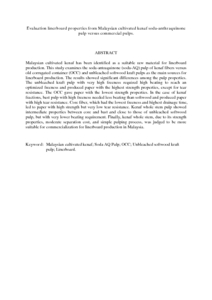Citation
Mossello, Ahmad Azizi and Harun, Jalaluddin and Ibrahim, Rushdan and Resalati, Hossien and Fallah Shamsi, Seyed Rashid and Md Tahir, Paridah and Mohad Yusoff, Mohd Nor
(2010)
Evaluation linerboard properties from Malaysian cultivated kenaf soda-anthraquinone pulp versus commercial pulps.
BioResources, 5 (3).
pp. 1595-1604.
ISSN 1930-2126
Abstract
Malaysian cultivated kenaf has been identified as a suitable raw material for linerboard production. This study examines the soda-antraquinone (soda-AQ) pulp of kenaf fibers versus old corrugated container (OCC) and unbleached softwood kraft pulps as the main sources for linerboard production. The results showed significant differences among the pulp properties. The unbleached kraft pulp with very high freeness required high beating to reach an optimized freeness and produced paper with the highest strength properties, except for tear resistance. The OCC gave paper with the lowest strength properties. In the case of kenaf fractions, bast pulp with high freeness needed less beating than softwood and produced paper with high tear resistance. Core fiber, which had the lowest freeness and highest drainage time, led to paper with high strength but very low tear resistance. Kenaf whole stem pulp showed intermediate properties between core and bast and close to those of unbleached softwood pulp, but with very lower beating requirement. Finally, kenaf whole stem, due to its strength properties, moderate separation cost, and simple pulping process, was judged to be more suitable for commercialization for linerboard production in Malaysia.
Download File
![[img]](http://psasir.upm.edu.my/14588/1.hassmallThumbnailVersion/Evaluation%20linerboard%20properties%20from%20Malaysian%20cultivated%20kenaf%20soda.pdf)  Preview |
|
PDF (Abstract)
Evaluation linerboard properties from Malaysian cultivated kenaf soda.pdf
Download (84kB)
| Preview
|
|
Additional Metadata
Actions (login required)
 |
View Item |

